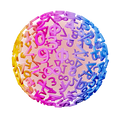Function Tables
There are various different kinds of function tables. Here, we’ll look at two types: One that is good at first, when you’re just learning about and getting used to functions, and a smaller, more professional table.
A function table is a table that shows which coordinates you are plotting in the coordinate system based on the function’s equation. It helps you draw the graph of the function.
In the beginning, it might be wise to use a table like the one below. It has four columns: A column for the -values you have chosen (or are told to use in the exercise), a column for calculating every value of , a column for the result of the previous calculation, and a column for the coordinates you need to draw the graph. It looks like this:
In the first column, you can see the -values. The function was this time. This is placed in the second column, where is replaced by the values we’ve chosen. In the third column are the -values—meaning the corresponding -values for each in the first and second columns. In the fourth column, the -values and the -values have been placed together together into coordinates . These are the coordinates you’ll insert into the coordinate system, and draw lines between, to construct a graph of the function.
A more professional function table only contains exactly what you need to draw a graph of the function. Simply put, the second and the fourth column are removed, because while they have useful information, they’re not absolutely necessary for drawing a graph. This second table is also aligned horizontally instead of vertically. Even though the coordinate (fourth) column is not included, the -values and -values still are, they are the coordinates, so you’ll still have everything you need to draw a graph.
| -values | ||||||
| -values | ||||||






















